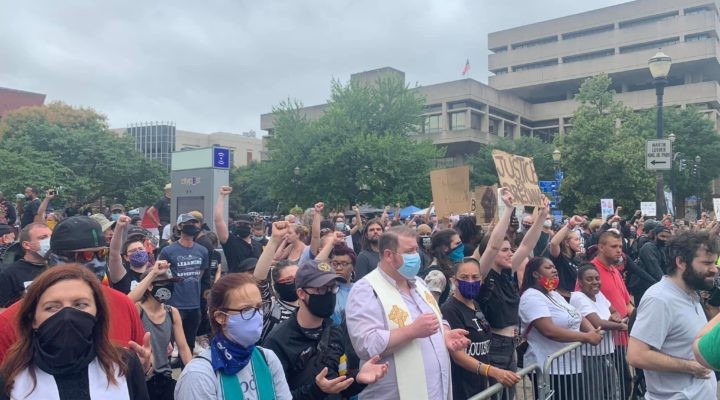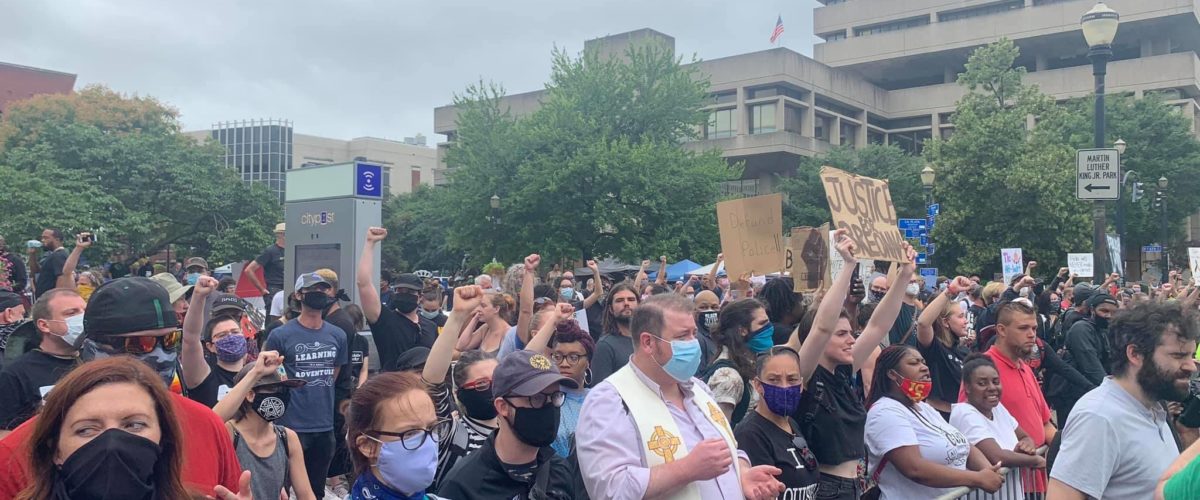Kevin Gardner-Sinclair has been part of a clergy group working among civil rights protesters in Louisville, where the national rally for racial justice has taken center stage since the police shooting of Breonna Taylor, a 26-year old Black woman who served the city as a first responder and EMT. She was shot eight times while officers were executing a no-knock warrant at her home. Since then, largely peaceful protesters against police killings of Black citizens have set up camp in what they call Injustice Park (Jefferson Square Park) in downtown Louisville. What follows is Kevin’s firsthand account of his experiences in the march for justice June 27.
Last Saturday, June 27, a paramilitary outfit of white nationalists threatened on social media to “take back” our city from the racial justice protesters occupying Injustice Park in downtown Louisville. They predicted that the encampment of largely peaceful protesters would be cleared by nightfall.

Kevin Gardner-Sinclair (center front in clerical stole) joins other Louisville clergy in a racial justice march June 27, 2020.
The Kentucky Alliance Against Racist and Political Repression sent out a call for the clergy community to show up and stand in the gap between the peaceful protesters and the white nationalists. Forty-five clergy and laity gathered at Christ Church Cathedral downtown before marching to Injustice Square to await the arrival of the militia. We came knowing we would be standing unarmed between groups of heavily armed, tired, angry folks — and during a pandemic.
We were Methodists, Presbyterians, Unitarian Universalists, Baptists and one Hindu cleric strong. We were organized by Ryan Eller, founder of the Kentucky Public House and my classmate at Wake Forest Divinity School, where Baptist saints like Bill Leonard, James Dunn and Frank Tupper helped us graduate from Gerber-Baby-Bible-school mush to the meatier reads of Roger Williams, Phyllis Tribble and the great Howard Thurman.
Ryan framed the day for us with these words: “If you came looking for a Kumbaya moment where white nationalists, the police and racial justice protesters hold hands and sing We Shall Overcome, today will probably not be your day. But if you came so that your presence might help prevent more bloodshed in our community, then we will count that a victory.”
As we marched and sang from the cathedral to the camp, we were stopped on the sidewalk by a racial justice protester who asked, “What are your intentions?” Walking two-by-two, I was in the second row, and turned back to find Ryan, who ran up to speak with the Square’s sentry. After a few words, the man’s eyes grew wide, and he said with a tone of shock and joy, “Oh, y’all are here for us?” Then he turned to the Camp and announced, “Hey y’all, God sent us these pastors!” And the crowd opened their arms to welcome us into their sacred space.
If Jesus is alive today (and I believe he is with my whole being), he is in downtown Louisville at Injustice Park standing with those whose backs are against the wall.
We were offered food, water and a tour of the camp with an unmerited hospitality of biblical proportions. We made our way to the front line behind the metal barricades between the police and the space designated for the white nationalists (who apparently had all the right permits and paperwork). In our training by Louisville Standing Up for Racial Justice, we were taught our task was to be a presence of peace and de-escalation. Specifically, our task as white clergy was to help de-escalate the white protesters (who were by far the rowdiest in the group, and the rowdiest of the rowdy were not from Louisville).
The privilege of white rage can result in the cost of Black suffering.
Zealous white folks who do care deeply about racial justice can step over the unspoken line, and when the forceful response comes it falls on the Black protesters primarily. The privilege of white rage can result in the cost of Black suffering, if not wielded wisely. Our trainer told us that centering ourselves and seeking to see the humanity in the eyes of the protesters, the police and even the white nationalists is fundamental to our role as de-escalating peacemakers.
At one point, my friend Erica Whitaker, pastor of Buechel Park Baptist Church, turned to one of the young, white protesters who was screaming obscenities and leaning over the barricade, and she casually asked him, like meeting a stranger in a grocery store, “Hey, thanks for coming out! Where are y’all from?” The young man, surprised by Erica’s inquiry, came back to himself and replied, “Uh, Memphis.”
“Oh, cool, I love Memphis! What brought y’all to town?”
“Uh, my girl is from here, and we’re just visiting.”
The conversation continued for a couple of minutes and concluded with him apologizing to Erica for cussing so much in front of a bunch of pastors (we tried to keep from clutching our pearls), and he went quietly back into the crowd.
One white police officer was on the line 20 feet ahead of us from 8:45 a.m. to 2 p.m. He looked miserable. I saw him wretch three times, as if whatever he imbibed the night before was prepping for an encore performance. His jawline clenched with every chant of, “No Justice, No Peace,” and his eyes seemed to gaze at nothing in particular with a mixture of exhaustion, frustration and shame — refusing to look anyone in the face.
Hours passed, and one of the Black pastors arrived and walked straight up to the front of the line. David Snardon stuck out his hand and said something to this young officer. I could not hear, but this pastor’s words woke the white officer out of his indifference. The officer stepped forward, shook hands with David, and I witnessed his callous expression soften as the red blood of his humanity flushed back into his face. His mouth turned to a slight smile as his lips formed the words, “Thank you.”
The white nationalists never entered downtown. The hundreds of peaceful protesters who arrived to protect the occupying protesters overwhelmed the dozen or so militia who came. A chapter of white supremacists from a neighboring county announced on social media they were staying home because of the size of the anti-racist crowd. Their own leader posted that he was not coming to Louisville because the billionaire George Soros had put a hit out on his head — a variation on a popular anti-Semitic conspiracy theory. We waited a couple of hours after the first reports of the militia’s departure before heading home.

A makeshift memorial to Tyler Gerth, slain by a gunshot at the June 27 march against racial injustice in Louisville.
That evening, we joined thousands of Louisvillians on a Facebook livestream after hearing the horrific news of a shooting at the camp. Tyler Gerth, a 27-year-old photographer, was killed by a man suffering from schizophrenia who had been asked to leave the camp multiple times for his violent behavior. Hours after the white nationalists left, this poor soul, who saw his mother murdered in front of him when he was 2, returned with a pistol and two full magazines of ammunition. The Camp was cleared, and the protesters were promised their belongings would be returned to them the next day. Instead, those belongings were thrown in a trash compactor, along with one pastor’s two grills he had been using to feed people every weekend.
The white nationalists, it appears, were prescient in their promise to clear the camp. They thought that by provoking enough rage and inciting enough destruction, the movement for justice in Louisville would be squelched. Normalized systems of supremacy could be orderly restored.
What they hadn’t anticipated is that Sunday night, we returned to light candles and speak the names of Breonna Taylor, David McAtee, and now Tyler Gerth, because the cycle of Crucifixion and Resurrection, Good Friday and Easter Sunday will continue on and on until one day when we no longer, “see through a glass darkly.” Until that day, we must continue to show up, bear witness and speak the names of God’s beloved into the void of human self-destruction plaguing our people since the days of Noah when, “the earth was filled with violence.”
William Sloane Coffin once preached, “Despite appearances, it is an Easter world.” As followers of Christ, tattooed with cruciform love, we oscillate between the paradoxical poles of crucifixion and resurrection. We are surrounded with Good Friday, but it is always an Easter world.
Despite appearances, it is an Easter world.
I share these experiences not as an agent, catalyst or organizer, but merely as a white witness in Black space. The racial justice protesters are the agents of justice and reconciliation. And in the words of Martin Luther King Jr. in his Letter from Birmingham Jail they are practicing “nonviolent direct action (that) seeks to create such a crisis and establish such creative tension that a community that has constantly refused to negotiate is forced to confront the issue.”
Breonna Taylor. David McAtee. George Floyd. Ahmaud Arbery. Tyler Gerth. Say their names, beloved. In Jesus’ name, say their names.
Their lives matter, Black lives matter. And despite appearances, it is an Easter World.


